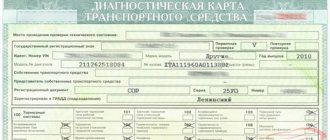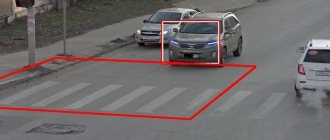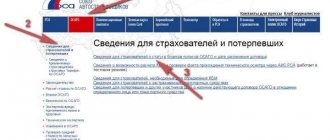Why do you need a policy?
How OSAGO stands for must be understood literally.
Those. Owner's liability is insured. This means that when an insured event occurs, damage to the property and/or health of the victim in an accident is compensated. The payment is made by the company with which the person responsible for the accident entered into an agreement. On the one hand, compulsory insurance increases the cost of maintaining a car, on the other hand, it allows you to resolve disputes and compensate for damage caused in an accident in a civilized way.
Having an MTPL policy guarantees that losses caused by its owner will be compensated by the company. It turns out that compensation for damage is not carried out by the person responsible for the accident personally, but by the insurer with whom he has an agreement. Moreover, the cost of the contract is much less than the compensation that can be paid to the injured party.
How is payment made if you are not at fault for the accident?
If you are not the culprit of the accident, the calculation is made as follows - you contact the insurance company and it, having assessed the amount of damage, makes a payment to you.
There are two caveats to this:
- The amount of damage will be calculated taking into account the wear and tear of your car, that is, the older the car, the greater the wear and tear. Depreciation is calculated as a percentage using a standard formula that takes into account the age and mileage of the car.
- According to the law, the maximum payment under compulsory motor liability insurance is 400,000 rubles. That is, if the cost of restoring your car is more than 400,000 rubles, then you have the right to recover the difference between the actual cost and 400,000 rubles from the culprit in the accident through the court.
About making changes
OSAGO can be changed if there are serious reasons. For example, if your driver's license was stolen, your last name was changed, or you decided to add a new person to the list of people who can drive your car.
Only the insurer has the right to adjust and make changes to the policy and only on the basis of an application from the policyholder. Please note that new data may worsen your KBM (bonus-malus), for example, if the new driver had traffic violations in the past and payments under compulsory motor liability insurance. If you are restoring your lost KBM due to a change in driver’s license, you may well receive a discount.
How to add another driver?
If you decide to allow another driver to drive, then you just need to go to your insurer with a policy, as well as a copy of the passport and driver’s license of the new participant.
You can also add one more novice driver in your personal account. This can be done if you purchased insurance online.
You will need to fill out an application and possibly pay extra to add a new person, as insurance may become more expensive.
Do I need to change the certificate when changing my license or changing my name?
When changing rights or personal data, you must inform the insurance company so that it can make changes to the policy and transfer new information to the AIS RSA database. You do not need to enter anything into the form yourself. Changing your ID or surname is not a reason for terminating the insurance contract.
For more details on whether it is necessary to replace your compulsory motor liability insurance policy when you change your driver’s license, surname or car owner, read here.
Design issues
To register a vehicle with the traffic police, you must first enter into an agreement with any accredited insurance company.
IMPORTANT! You need to receive an MTPL policy no later than 10 days after purchasing the car.
How to get an MTPL policy and what you need for it
To do this, the company employee must provide the following documents:
- application for concluding a contract;
- identification document (passport or other document);
- PTS, registration certificate or STS;
- driver's license;
- diagnostic card;
- power of attorney (if the car belongs to another person).
Car owners expect to receive the maximum guarantee of payments in the event of an accident. Therefore, it is necessary to take a responsible approach to choosing an insurance company. The Expert RA rating agency constantly updates ratings of the financial reliability of insurers. You can view them on the website https://raexpert.ru/ratings/insurance.
Briefly about choosing an insurance company
Various Internet sites will help you make your choice, which contain detailed reviews of insurance companies, the positive and negative aspects of each of them.
Is it possible to make changes to the current OSAGO policy?
So, you have the MTPL policy in your hands. Did you know that it is mandatory to report all changes in your personal data during the validity period of the document to the insurance company? This should be done immediately, as the terms of the contract may change. For example, this applies to moving to another region. The owner can provide new passport details or add an additional person to the insurance by visiting the office of the insurance company or sending an electronic application via the Internet.
Is early termination possible?
Insurance rules allow the contract to be terminated ahead of schedule. But before you decide whether you can terminate your insurance, study the list of situations in which you have the right to do so:
- The death of the owner of the car.
- An accident after which the car cannot be restored.
- Termination of the insurance company's license.
- Change of car ownership.
If one of the described cases occurs, you must submit an application and a document confirming the right to terminate to the insurance company. After all formalities have been completed, the insurance company will return the remaining insurance premium to you.
Types of car insurance
How to decipher CASCO and OSAGO?
OSAGO is, in fact, the formal name of an insurance policy, and drivers more often use the word “motor citizen”.
What is the essence of OSAGO insurance?
The principle of compulsory motor liability insurance is that a driver found guilty of committing an accident must bear responsibility for what happened and must compensate for the damage caused to the health, life or property of the injured participant in the incident. The principle applies regardless of whether the car owner intentionally or unintentionally caused harm to another person and his property.
In fact, auto insurance protects not only those injured in a car accident, as many people think, but also drivers, since insurance is associated with the risk of their civil liability. Motorists annually buy an MTPL policy, and in the event of a traffic accident, the insurance company covers the damage caused with this money.
The MTPL policy, according to the law, is a public contract. Therefore, any insurance company operating under the auto insurance system is obliged to issue a policy to each citizen who applies with the appropriate written application and a package of necessary documents. Tariffs and insurance rates are regulated by the Central Bank of the Russian Federation.
Thus, the essence of compulsory motor liability insurance is that a motorist or pedestrian injured in a traffic accident will be paid compensation for damage caused in the amount necessary for the restoration of the car or treatment and rehabilitation after injuries. The person responsible for the accident will repair his car at his own expense.
CASCO insurance
- material damage to the vehicle, both partial and complete (destruction of the vehicle);
- theft or, in fact, theft of a car;
- driver and passengers from an accident;
- optional equipment.
Insurers may offer to separately insure possible damage. All other subjects are necessarily insured only together with damage. It is not possible to insure them separately under CASCO insurance.
Since CASCO is not a compulsory type of insurance, but exclusively voluntary insurance, it is regulated only by the Insurance Rules. The insurer has every right to refuse to issue a CASCO policy to the car owner without giving reasons. The conditions of insurance under the CASCO system may differ among different insurance companies.
Therefore, in order to purchase a policy, the car owner must present the car to the company’s employees for inspection. Based on the results of the inspection, a report will be drawn up that shows all existing damage to the car. It is, taking into account this inspection report, that insurance payments will subsequently be made.
In fact, with CASCO insurance, the car owner will receive compensation for his damaged car. Comprehensive car insurance is not a requirement. If desired, the car owner can enter into an agreement solely against causing damage to his iron horse.
Payment terms
How long does it take for insurers to transfer funds to a victim in an accident? According to the law, this is 20 days after accepting a statement from the victim, but not after the accident! Also, when calculating the deadline, you should take into account the possibility of holidays and add them to the total waiting period.
The insurance company is financially responsible for delays in payments. According to the legislation of the Russian Federation, a penalty for a day of delay is accrued at the current rate of the Central Bank.
In fact, receiving funds from insurance companies lasts for a long time - six months or even a year. Insurers underestimate the amount of losses, clients go to court, independent experts work, the results of examinations are disputed, etc.
How to avoid such problems?
- When choosing an insurer, check the information about the financial condition of the organization. As a rule, small enterprises that have problems with financing engage in delaying time.
- If the situation reaches a dead end, file a complaint with the RSA, but don’t expect a quick solution there either.
Large companies pay funds on time, but at the same time deliberately underestimate the amount of damage, hoping that the victim, having received a certain amount in a short time, will not go to court.
Types of CASCO
As we found out, this type of insurance is exclusively voluntary. There are several policy options.
Any car owner can insure his vehicle with an auto policy, using several of its variations:
- Damage. This option is the most popular. The document covers damage resulting from a transport accident, natural disaster, or fire. In addition, such insurance involves compensation for damage received from people or animals.
- Hijacking. Not the most popular way of insurance. The problem is that almost all insurance companies, as a prerequisite, require the installation of a special satellite search system, blockers or other protective devices on vehicles. Not every organization is ready to issue such a policy option, since there is a risk that the owner of the vehicle will rush to get rid of such personal transport.
- Comprehensive insurance. Combines the two car policy variations presented above. This type of Auto and CASCO is recommended to be issued if the car owner bought the vehicle on credit or he is the owner of an exclusive car.
The ability to choose the type of insurance that is convenient for you is a great success. Definitely, of the presented options, the third one is the most reliable. However, the cost of such a car policy is high. What makes it so expensive and inaccessible? Let's consider what the cost of CASCO depends on.
What is meant by compulsory motor liability insurance?
The abbreviation OSAGO stands for the following:
- Firstly, OSAGO is one of the types of insurance. The main feature of this is that it is mandatory, that is, the driver does not have the right to drive on the roads without having such insurance with him.
- Secondly, the concept stands for compulsory motor third-party liability insurance. Already from the transcript it becomes clear that every car owner should have insurance.
If the driver does not have it issued or does not have it with him, then he will face a fine or deprivation of his license.
OSAGO is considered a so-called public contract. This means that each insurance organization undertakes to issue this type of insurance to the client who contacts them.
Every driver needs a policy because:
- He determines the culprit who caused the accident.
- Allows you to cover repair work on your car. The maximum amount of compensation is regulated by law. It also issues compensation if there are persons injured in the accident (the amount is also regulated by law).
- Pays compensation to third parties.
Important: if the amount of damage exceeds the settled amount (if only property was damaged in the accident, then payments will not exceed 400,000 rubles; if damage to health was caused, 500,00 rubles), then the culprit of the accident must pay the balance. The contract provides, as is already clear from the description above, two risks: harm to health and damage to the car.
The contract provides, as is already clear from the description above, two risks: harm to health and damage to the car.
The legislation wants to consider a project that would increase the number of risks under compulsory motor liability insurance. However, this project is only in development, so there is no clear answer to the question posed today.
Insurance payments
In the case of compulsory motor liability insurance, tariffs are regulated by the Central Bank, so the cost will be the same everywhere.
To receive payments under compulsory motor liability insurance or an insured event, you must:
- contact the organization where the car was directly insured;
- or contact the organization where the person responsible for the accident is insured.
Important: before contacting the insurance company for compensation payments, you must collect all the required documents and make a copy of them. Without them, no compensation will be made.
The calculation of payments is made taking into account the damage: an expert assesses all the damage (this can be done by a service station, which will subsequently repair the car). But in this case, only the victim will receive his payments. Not only will the culprit not receive any compensation from the insurance company, but he will also have to pay the rest of the full amount if the amount of damage is more than 400,000.
What it is
Compulsory motor third party liability insurance for vehicle owners is one of the types of insurance provided for citizens of the Russian Federation.
Upon its acquisition, the insurance company assumes obligations to compensate losses to injured persons as a result of the damage caused within the limits of the assigned insurance payment.
In this case, the amount of the insured amount is:
| for injury caused to the life and health of any victim | 160 thousand rubles |
| for damaged property under a policy purchased from the beginning of October 2014 | 400 thousand rubles |
The MTPL policy is stored together with transport documents and is presented to the traffic police inspector upon his first request. If the driver cannot present it to the road safety inspector for any reason, then he has the right to seize the car and send it to a impound parking lot.
The policy does not guarantee protection in case of vehicle theft or damage. Upon expiration of the policy, it is necessary to keep it for five years, as it will affect the cost of insurance under compulsory motor liability insurance in the future.
How is the amount of insurance determined?
Back in 2014-2015, many people noticed that the price of cars varies. At the end of 2014, the concept of “insurance corridor” was defined, thanks to which insurance companies manipulated prices and competed
How is insurance calculated nowadays?
Russian laws define a general system for calculating insurance rates. For example, a single basic calculation for MTPL tariffs is used everywhere. But besides this, other factors also influence the total cost of the policy:
- Transport category and type. That is, whether the transport is passenger or cargo, whether it is owned by an individual or a legal entity. All types and categories correspond to their coefficient - some vehicles are involved in accidents more often than others.
- Territory. If the city is large and populated, then the likelihood of an accident is greater than in a small one. The cost of insurance is determined by territorial reference, so all regions have their own tariff, which is provided for by the law on compulsory motor liability insurance.
- Experience in driving vehicles. Of course, a person who knows how to drive is much less likely to get into an accident. The age of the driver is also important here.
The following are worth noting as secondary indicators:
- Technical data of the vehicle;
- The time of his insurance;
- Have there been accidents before and if so, who was the at-fault party.
What is a “direct settlement” under compulsory motor liability insurance?
A direct claim settlement is a situation in which a person injured in an accident must apply for payment from their insurance company.
Necessary conditions for direct settlement of losses:
- The accident involves two vehicles.
- There were no casualties in the accident (no damage to health).
- Both participants in the accident have valid MTPL policies.
In other cases, the victim of an accident must contact the insurance company of the culprit.
Insurance price
Policy rates are also regulated by law. However, the price range can be significant as many factors influence the cost. The minimum limit for category “B” vehicles is 3,432 rubles, and the maximum limit is 4,118 rubles. Multipliers are applied to the base rate depending on certain factors. These include:
- engine power, since the more powerful the vehicle, the higher the risk of getting into an accident according to statistics;
- region of registration of the vehicle or residence of the owner, in large cities this is an increasing coefficient, in small settlements this is a decreasing coefficient (depending on the risk of getting into an accident);
- the age and experience of drivers is determined by the youngest and most inexperienced driver (with unlimited insurance, the maximum increasing coefficient is set);
- the duration of the insurance, the minimum period can be 3 months (coefficient will be 0.5), and the maximum period 1 year (coefficient 1);
- KBM, a coefficient that determines the period of accident-free driving for each driver, is set based on the minimum value of one of them.
If you have certain advantages based on these factors, you should know that you are entitled to a discount. Many insurers enter into contracts at maximum rates, which has led to a significant increase in the cost of insurance. Therefore, before you insure yourself, check the amount of your insurance using an online calculator. All insurers calculate the policy amount using the same formula, so regardless of the company, it will be the same. You can find such a calculator on any insurer’s website, as well as on the official website of RSA.
Then the cost of insurance will be recalculated for you and the overpaid funds will be returned.
Insured events and cost of the policy
A motor vehicle insured event is the occurrence of civil liability as a result of causing harm to the life, health or vehicle of the victim or victims. OSAGO applies only to those cases when the driver (aka the policyholder) was driving the car.
An insured event is an accident involving two participants - that is, the culprit and the victim. In addition, the incident must take place on the road or adjacent area. Another important point is whether the person at fault for the accident has MTPL insurance. Without it, the person in question will not be able to cover the damage caused by the insurance company, which means he will have to pay compensation to the victim out of his own pocket.
The cost of the policy is determined by a special calculation formula, so it is impossible to say the exact price - it is determined individually in accordance with the characteristics of the car, the parameters chosen by the car owner and other aspects.
What does the insurance price consist of?
- The base rate is the initial cost that is set by the insurance company and which is then multiplied by all of the following factors;
- City of residence coefficient - this may differ in one insurance company depending on the region of registration of the car;
- KBM - a discount for accident-free driving, which is awarded to motorists for a period without an accident;
- Coefficient of age and driving experience;
- Limited or unlimited policy;
- Vehicle power;
- Seasonality of vehicle use;
- Insurance law violation rate.
It is worth noting that in 2021 there have been some changes in insurance. They touched upon basic tariffs and coefficients of age and driving experience.
First of all, it must be said that a tariff is a price corridor, from minimum to maximum, which allows insurance companies to choose themselves. Basic tariffs vary depending on different categories of cars and types of vehicles themselves.
The changes also affected the coefficients of experience and age. So, there are more gradations themselves. Previously, there were only four of them - younger or older than 22 years, less or more than 3 years of experience. Now there are as many as 56 of them. In addition, the coefficient values for young, inexperienced drivers have generally increased, while for older drivers with more experience they have decreased.
You can calculate the cost of compulsory motor liability insurance in different insurance companies, taking into account all existing changes, at Vyberu.Ru. Our online calculator allows you to calculate the cost of a policy based on the data you enter and select insurance from one of the companies operating in your region in a matter of minutes.
OSAGO: what is it?
This is a policy that insures the driver against serious financial costs in cases where he accidentally gets into an accident due to his own fault.
The insurance company will pay for the damage to the victim. The abbreviation OSAGO stands for Mandatory Automobile Liability Insurance. The possibility of its introduction was first considered at the beginning of the second half of the 20th century, but only in 2002 did the corresponding law No. 40-FZ “On OSAGO” appear. In a relatively short period of action, it has already undergone many changes.
OSAGO is mandatory in Russia. It must be issued within 10 days after purchasing the car, or the car will not be registered with the traffic police. This is necessary so that the victim of an accident can be sure that he will receive compensation for damages. However, the car owner must remember that the insurance company has a so-called “limit of liability”. That is, she will be able to pay the victim no more than 400 thousand rubles or 500 thousand rubles in case of harm to health. Amounts above this limit must be compensated by the car owner himself.
Definition
The abbreviation means: compulsory motor vehicle liability insurance.
A more detailed translation of this abbreviation looks like this:
- mandatory: any vehicle on the territory of Russia must be insured;
- automobile civil liability: compensation for damage in case of an accident is made to everyone except the person responsible for the accident.
What does he look like
The new model OSAGO has a QR code. It is located in the upper right corner of the paper (pink) policy. This icon is not available in electronic MTPL.
A QR code is a kind of link to an Internet page. To decrypt it, you will need a special application for your smartphone. The code needs to be photographed. After this, the program will automatically redirect the car owner to the RSA website.
The following information is displayed on the page:
- car registration number;
- VIN number;
- machine data;
- duration of the policy;
- the name of the insurer that issued the policy.
The QR code helps verify the authenticity of the policy.
Also, in the new model MTPL, in the “insurance premium calculation” column, a plate with coefficients appeared. Thanks to this, the car owner will be able to figure out which numbers make up the final amount.
In the plate that lists the persons who are allowed to drive a vehicle, you can now indicate the driver’s class in the corresponding column.
In the “Vehicle Owner” field, the following driver data is indicated: age, number of accidents and length of service. Based on your driving experience, the KBM coefficient is calculated, which affects the price of the MTPL policy.
Who is the insured in the MTPL policy?
The insurance policy has two lines to indicate information about the policyholder and the owner of the vehicle. Most often, the owner of a car becomes its policyholder. However, cases arise when “on paper” the owner of the car is the spouse, but the car is in constant use by the wife. It is more convenient for the spouse to make insurance on their own and then the policyholder and the owner can be different persons . The policyholder will need to provide the insurance company with a power of attorney to drive the vehicle, issued by the owner of the car.
In addition to the power of attorney, the policyholder must provide the following documents:
- own passport;
- driver license;
- vehicle passport confirming registration;
- a valid vehicle inspection certificate.
Data about the policyholder and the owner of the car are filled in in two different lines:
How is it regulated and how does it work?
Compulsory motor liability insurance is regulated by Federal Law No. 40. You can read the text of the law here: https://www.consultant.ru/document/cons_doc_LAW_36528/
OSAGO works like this: if an accident occurs through no fault of the policy owner, the insurance company compensates him for the damage.
The MTPL law provides for compensation for damage through repairs, and only in exceptional cases - in money.
Also, the law on compulsory motor liability insurance provides for a penalty for late payment of damage.
Algorithm of actions to receive the maximum payment under compulsory motor liability insurance:
- Contact the insurance company yourself, or through a representative you can trust. In this case, you need to provide documents without bank details. Thus, the insurer will not be able to make a payment ahead of time.
- Get directions to the service station and go there. The referral (or its copy) must be stamped, as well as the date of application.
- Wait no more than 3 months for the car repair to be completed: the penalty is charged at the rate of 1% per day. In 3 months approximately 90% will accumulate.
- If the repairs are delayed, file a claim for payment in cash. In this case, the owner of the vehicle will need to provide documents with bank details. In this case (including 7-10 days during which the claim will reach the accounting department), the driver is charged a penalty in the amount of 100% of the damage. The vehicle owner receives the main damage payment.
- After receiving payment for the damage in money, contact the insurance company with a special form of claim.
- If there is no payment, then you need to contact the ombudsman for compulsory motor liability insurance. He makes a decision similar to a judicial one.
If the car is less than 5 years old and the mileage is less than 150,000 km, then the driver is entitled to a TTC payment.
A template for a claim for repairs instead of payment can be downloaded here: https://apretenzia.ru/documents/strakhovanie/36/?utm_source=youtube&utm_medium=algoritmosago2020&utm_campaign=docnaremont
A template for an application for payment of TTS can be downloaded here: https://apretenzia.ru/documents/strakhovanie/14/?utm_source=youtube&utm_medium=algoritmosago2020&utm_campaign=docuts
Who is an insurer
The insurer is an insurance company that issues MTPL policies to protect the property interests of drivers. This document is paid. Its cost is regulated and calculated in accordance with legal requirements. You can issue a policy not only directly from the insurance company, but also through indirect representatives:
- insurance agents;
- brokers.
Insurance agents typically represent the services of a specific insurance company. The cost of such a policy is slightly more expensive, since the agent takes a commission for the work . The driver receives the advantage of saving personal time. The agent can come to a place and time convenient for the client to conclude an insurance contract.
Brokers provide the services of several insurance companies at once, and the policyholder has the opportunity to choose a more cost-effective policy.
Differences in the decoding and rules of CASCO and OSAGO
So, the interpretation of CASCO and OSAGO has significant differences. As well as types of insurance. In the first case, the object is your own car, in the second case, the vehicle that was injured due to the fault of the client. Under CASCO, all damage is compensated; under OSAGO, there is a limit established by law. OSAGO implies compensation for harm caused to the health and life of victims, but CASCO does not. And finally, every car owner must apply for MTPL, and CASCO - on a voluntary basis.
Explanation of CASCO and OSAGO
OSAGO does not take into account the costs associated with the restoration and repair of their car, so many drivers choose CASCO to have a guarantee of a refund in case of damage or loss of the car. In addition, due to the limits on compulsory motor liability insurance, this amount is often not enough to compensate in full and the client is forced to pay the balance himself.
What to do in case of an accident
Procedure in case of an accident:
- Turn off the engine, turn on the emergency lights.
- Place an emergency sign at the rear of the car.
- Make sure no one is injured in the accident. If there are victims, you need to call an ambulance.
- If there are no injuries, and there are only 2 participants in the accident, then together with the second driver, determine the culprit of the accident.
- If it is impossible to identify the culprit of the accident, call the traffic police. This must also be done if the second driver does not have an insurance policy.
- If one of the drivers admits guilt, both have compulsory motor insurance, and the accident is minor, then you will need to draw up a diagram of the traffic accident (without calling the traffic police). The next stage is filling out the European protocol.
According to the European protocol, compensation of up to 100,000 rubles is expected. In Moscow (and the region) and St. Petersburg (and the region) - up to 400,000 rubles.
If a pedestrian is injured in an accident, the insurer of the person responsible for the accident will reimburse the cost of treatment and loss of salary. If the pedestrian is at fault for the accident, then he does not have the right to receive compensation under compulsory motor liability insurance.
What OSAGO can protect you from
In accordance with the provisions of the law on compulsory motor liability insurance, each car owner is now required to enter into a separate agreement on insurance of the risk of liability of the vehicle owner. In the Russian Federation, damage to property, health and life of victims from the actions of a violator insured under compulsory motor liability insurance as a result of an accident is subject to compensation.
It should be precisely understood that the MTPL policy is issued for a car, and not for a specific person. Therefore, if you get behind the wheel of a car that you do not own, then you must have not only a power of attorney to drive it, but also compulsory motor liability insurance for this vehicle. You must also be included in it. Likewise, if you own several vehicles at once, then each of them must have an MTPL policy.
OSAGO coefficients and payments
The latest version of the law provides for a significant increase in the limit of compensation payments to 400,000 rubles, and from April 1, 2015, to 500,000 as compensation for damage to health and life. Moreover, insurance companies have already stated that such an increase in insurance payments will automatically make it unprofitable for them to do business, so in the near future the cost of compulsory motor liability insurance policies will increase further.
Basic insurance rates for 2021 are as follows:
- passenger vehicles of individuals and individual entrepreneurs – from 4118 rubles;
- taxi – from 6166 rubles.
Also, when calculating the cost of compulsory motor liability insurance, increasing and decreasing coefficients are taken into account. They depend on the power of the car engine, the place of residence of the car owner, as well as his age and driving experience.
For example, according to the last criterion, the table of coefficients looks like this:
- Experience – n/a 3 years, age – n/a 22 years, coefficient – 1.8;
- Experience – n/a 3 years, age – n/a 22 years, coefficient – 1.6;
- Experience – n/a 3 years, age – n/a 22 years, coefficient – 1.7;
- Experience—n/m 3 years, age—n/m 22 years, coefficient—1.
Why every motorist should have MTPL insurance
An MTPL policy is a mandatory document that a driver must have while driving a car. The absence of a policy is an offense that is punishable administratively with a fine of no more than 800 rubles. Let us note, by the way, that such a widely practiced practice in the past as the removal of license plates for lack of compulsory motor liability insurance has lost its relevance today. Therefore, the most serious thing that a driver faces for lack of insurance is a small fine and, of course, the lack of confidence that in the event of an accident the driver will not have to pay a large amount to compensate the victim.
Differences between OSAGO and DSAGO and CASCO
There are different types of road accidents. Extensive damage to the car may not be covered by the insurance amount. To avoid such cases, it is possible to take out DSAGO - voluntary motor third party liability insurance. The point is that the payment amount increases to 2-3 million rubles. The tariff schedule consists of several levels and differs in the cost of the policy and the amount of damage coverage in the event of an insured event.
OSAGO and DSAGO policies will not help restore the property of the culprit. In order not to risk losing money for repairs, especially if it is a new or expensive car, you can take out a CASCO policy. This type of insurance is aimed at compensating for damage resulting from an accident, theft, hooliganism, etc.
The price of a CASCO policy is much more expensive than compulsory motor liability insurance and depends on the following factors, such as the year of manufacture of the car, its make, color, driving experience and the age of the owner.
But there is also an opportunity to reduce the cost of insurance if you choose the option of taking out a policy with a deductible. Read more about this in our article.
What is a franchise under OSAGO
A deductible is a certain part of the damage that the car owner compensates independently upon the occurrence of an insured event. Often its size is a fixed amount or a percentage of the cost of the car.
OSAGO abbreviation decoding
The decoding of this abbreviation speaks for itself - this is Mandatory Automobile Liability Insurance
It is difficult to overestimate its importance: every driver must take out a policy, and failure to comply with this rule guarantees penalties and sometimes even legal proceedings
The legislative act on compulsory insurance for drivers was published only in 2002 and during this time has undergone a number of amendments. Compulsory motor insurance is regulated by the Federal Law “On Compulsory Civil Liability Insurance of Vehicle Owners”, amendments made to it, as well as the Rules supplementing it.
Since the signing of the law, its meaning and decoding have remained unchanged. This policy allows the insured (that is, the policy owner) to relinquish responsibility for paying compensation to the party injured in the accident. That is, if for some reason you become the culprit of an accident in which the property or life of another driver or his passengers was damaged, it is not you who will pay compensation, but your insurance company. Thus, the policyholder does not need to rack his brains about where to get a large sum of money to pay compensation - especially in cases where the driver himself or his vehicle was injured.
It is important to take into account that vehicle owners insure their civil liability at their own expense. Any vehicle is subject to insurance, except:
- Vehicles whose maximum speed does not exceed 20 km/h;
- Vehicles that, due to their technical characteristics, are not subject to the legislation of the Russian Federation on admission to participation in road traffic;
- Vehicles of the Armed Forces of the Russian Federation, except for buses, cars, etc.;
- Cars registered in foreign countries, but provided that civil liability is insured in the international insurance system;
- Trailers for cars;
- Vehicles without wheeled propulsion systems - tracked, half-tracked, sleds, etc.
What does the abbreviation mean?
In order to streamline relations related to the civil liability of car owners and reduce the level of criminal tension in this area, OSAGO was introduced in Russia, the term stands for compulsory motor third party liability insurance (OSAGO).
In practice, this is expressed in the fact that each car driver has the obligation to draw up an appropriate agreement, which is confirmed by a special document - a policy.
The Institute of Motor Liability Insurance is not an invention of Russian legislators. This is a worldwide practice. Thus, such mechanisms were first used in the USA in the 20s of the last century. Already 50 years later, analogues of the modern Russian compulsory motor liability insurance were used in many countries of North America and Europe.
In Russia, the initiative on motor third-party liability insurance has been introduced for many years, but the corresponding law was adopted only in 2002, and since 2003, the presence of an MTPL policy has become mandatory for all drivers.
Attention! Initiatives to introduce the institution of motor vehicle liability were also put forward during the existence of the Soviet Union. However, all of them were rejected due to inexpediency.
Today, MTPL policies are issued by all drivers without exception. As a general rule, the parties to the insurance contract are:
- Insurers . Insurers should include specialized organizations - insurance companies that have a license to operate in the area in question.
- Policyholders. Persons (both individuals and legal entities) who own vehicles and have entered into an appropriate agreement with an insurance company.
Separate mention should be made of the form of the policy. If previously it was carried out only on paper, which was necessary to constantly have with you while using the vehicle, now the policy can be issued electronically. In the latter case, it is still recommended to take a printout of it with you.
It is also useful to read: Diagnostic card
Design rules
To apply for compulsory motor liability insurance you must present:
- passport;
- certificate of registration of the vehicle or PTS;
- driver's license;
- diagnostic card if the car is older than three years.
Reference! The same documents are uploaded in the form of scans if you are insuring yourself for the first time and decide to apply for compulsory motor liability insurance via the Internet. The insurer checks the package of papers, and sometimes inspects the car, after which it calculates the tariff.
Instructions for registration of compulsory motor liability insurance:
- Contacting the insurance company and providing a package of documents.
- Filling out an insurance application form.
- Studying the Insurance Rules and the text of the policy.
- Signing of the MTPL agreement.
- Payment for insurance.
The insurer issues the client not only a policy, but also two road accident notification forms, which must be taken with him in case of an accident. When filling out the application, be sure to indicate the make, model of the car, your experience as a driver, age, and all contacts.
On the back of the application you will need to enter all the persons you plan to allow to drive, the diagnostic card number and, if there is an old OSAGO policy number.
The application is signed personally by the policyholder. If it is submitted via the Internet, then a simple electronic signature is used for signing (a special code that the insurer sends to you by email or phone).
- applications for concluding an MTPL agreement
- applications for concluding an MTPL agreement
Is it possible to get it in installments?
Typically, compulsory motor liability insurance is issued for a year and the car owner immediately pays its cost, but it is possible to issue an insurance policy for three months with the right to extend. In this case, the driver will pay less. Please note that failure to pay your insurance on time will result in it becoming void.
You can learn more about purchasing an MTPL policy in installments from this article.
What does a compulsory motor liability insurance policy look like?
Externally, the document has not changed significantly in 15 years. The latest version of the form appeared in 2021. It was improved and made more secure as the number of counterfeits increased after tariffs were raised.
The contents of the policy have not changed. It still contains the following information:
- name, series and number of the document;
- start and end dates of the policy;
- information about the parties to the contract: information about the insurance company and personal data of the car owner;
- vehicle make and model, registration data, trailer availability;
- persons authorized to drive the vehicle, if any;
- excerpts from legislation;
- insurance premium amount;
- date of conclusion of the agreement and signatures of the parties.
Some forms on the reverse side may contain information on additional types of insurance concluded together with compulsory motor liability insurance (life insurance, property insurance, etc.).
Cost of OSAGO
A unified calculation of the price of an MTPL policy is carried out according to the tariffs established by the Central Bank of the Russian Federation. The calculation takes into account the power of the car, the region of residence of the car owner, the number of people who have access to drive the vehicle, as well as the amount of driving experience, age, and the presence of previous accidents.
But with the cost of a CASCO policy, more questions arise. The main one is why is it expensive, and is it really necessary to take out insurance? After all, the insured event may not occur, but a rather impressive amount will have to be paid now.
There are several CASCO programs. This determines what the insurance payment will cover. Basically, when calculating the price of the policy, the market value of the car, the place and year of registration, the experience and age of all vehicle drivers, the volume of insurance risks, and the presence of protective equipment in the car, for example, GPS and alarm systems, are taken into account.
Who needs car insurance
All drivers who are allowed to drive a vehicle need to be insured. If a person gets behind the wheel, then he can already become a reason for an accident and damage to other road users. Even if you do not personally own a car, this does not relieve you of responsibility. If you drive a certain car, you must be included in the insurance. Violation of the established rules may result in administrative liability. In addition, the absence of an MTPL insurance policy does not give you the opportunity to register your car.
How to calculate the cost of compulsory motor liability insurance
The cost of the policy is determined by the insurance company within the limits established by the Central Bank of the Russian Federation.
The online calculator uses tariff data for the current period established for individual cities and regions. The cost of the policy is determined by the rating of the insurance organization, the type of vehicle, the power of the vehicle, the duration of operation and other factors.
Procedure to submit a request for calculation in the online calculator:
- Go and register on the insurance company's website.
- Select the appropriate insurance option.
- Enter your personal information and mailing address.
Wait throughout the day and a company representative will contact you. The result of the KBM calculation will wait about a day to the specified contact address.
How to change or restore OSAGO?
If your data* specified in the insurance policy has changed (for example, you have changed your last name, first name, patronymic, changed your license, want to include another driver in the policy, etc.), you need to make changes to the MTPL policy. If you have an electronic MTPL policy, most often you can make changes (all or some) in your personal account on the insurance company’s website. If you have a paper policy, you will have to come to the office and write a corresponding application. Please contact your insurer for details. Please remember that the insurer has the right to demand payment of an additional insurance premium in proportion to the increase in the degree of risk based on the insurance rates for compulsory insurance in force on the day of payment of the additional insurance premium.
If you lose a printout of your electronic policy, you can download it from your personal account on the insurance company’s website and print it out again, or save it on your mobile device and present it if necessary. If you have lost or damaged your paper OSAGO policy, you need to contact your insurance company in person. A new policy will be issued free of charge. It will be valid until the end of the validity period of the lost one.
Replacing the vehicle specified in the compulsory insurance policy, changing the insurance period, as well as replacing the policyholder are not allowed.
CASCO
If you know a specialist who knows insurance, ask him if the term CASCO has an abbreviation for this abbreviation?
Most will answer positively, and will even spell out the name for you:
- K – complex;
- A – automobile;
- C – insurance;
- K – except;
- O – responsibility.
However, CASCO does not have an abbreviation - it is just a myth that appeared by analogy with compulsory insurance. In fact, this type of policy cannot even be considered completely “automobile”, since there are different types intended, for example, to insure ships or even aircraft.
The rule of writing the term “CASCO” in capital letters also took root by analogy with OSAGO, although this point still remains controversial.
But since the word CASCO exists, how does the abbreviation stand for? There is no such thing, but the word actually comes from its Italian “ancestor” - casco. If you turn to the dictionary, you can see that in translation this word is translated as “board”. In fact, this is quite logical, because by purchasing additional car insurance, you are actually insuring the side of your car.
Incorrect transcript versions
Many people try to decipher CASCO on the basis of other foreign words, so the following designations may appear on the Internet:
- Cascade (English) is often translated literally because it refers to an acrobatic sequence of simulating a fall. This word is often used by people whose profession is associated with spectacular exercises - figure skaters, circus performers, etc. How is decoding used for CASCO? The logic of the supporters of this interpretation is that damage under this insurance program is only an imitation for the owner of the vehicle, because it will be restored free of charge.
- The next term has already been borrowed from the French language - casque. The translation of this word means a helmet, which was used in the equipment of the French army until the 19th century. When interpreting, they refer to the fact that this insurance policy acts only as nominal protection, but does not insure the main thing - the lives of the owner of the car and his passengers.
- The word "casco" means "skull" in Spanish. Proponents of the origin of the term precisely from this word reinforce their words by the fact that in the past, drivers in Spain actually applied a skull through a stencil to the body of their vehicle. Thus, all pedestrians were warned about its danger. And the first insurance policies issued actually had images of a skull.
All the examples described above are considered erroneous. However, it has still not been possible to reliably determine the country of origin of this term. Historians are still inclined to believe that the ancestors of the modern CASCO system were born during the Middle Ages on the Apennine Peninsula, which is why it is generally accepted that this is where this word comes from.
So we have deciphered the terms MTPL and CASCO. These are two different insurance systems, with different approaches and degrees of responsibility. They have many more differences and features, so it is better to read more about them in our thematic articles.
What is the responsibility under compulsory motor liability insurance?
Liability under compulsory motor liability insurance: if an accident occurs due to the fault of the policy owner, then the insurance company compensates for the damage not to him, but to other drivers injured in the accident.
Key points to remember:
- When filling out a notification of an accident, you should remember point No. 15. It is called “Note”. At this point, the driver who does not consider himself guilty of the accident must write that he does not admit guilt and has no claims. The second side writes this: “I consider myself guilty of the accident, I have no complaints.” Both drivers sign. Otherwise, you may be denied compensation for damages.
- The accident must be reported to the insurer within 5 working days. If the company fails to report the accident, according to the MTPL law, the guilty party may be subject to a recourse claim. This means that the insurance company will pay the second party involved in the accident, and will demand compensation from the first driver.
- To increase the payout limit, you need to sign up for an unlimited Euro protocol. To do this, you will need to download the “European Accident Protocol” application. It allows you to record the fact of an accident and link it to GPS data. To use the application, you need to register with State Services.
- The vehicle owner must have a valid diagnostic card. Otherwise, the MTPL law allows insurance companies to refuse payment. In the worst case, you may face a recourse claim from the insurance company. Even if the owner of the vehicle has taken out compulsory motor liability insurance with a valid policy, but it expired during the policy period, then you can get regressed.
- If drivers have a disagreement, or something else other than cars was damaged during the accident, or the health of pedestrians was harmed, you must call the traffic police.
Related article: Driving experience in MTPL and how it is calculated for insurance
Subparagraph 1 of Article 14 of Federal Law 40 was repealed by another law - Federal Law 88 of May 1, 2021. Responsibility was removed, but the obligation remained. This is stated in paragraph 2 of Article 11.1. Federal Law 40.











